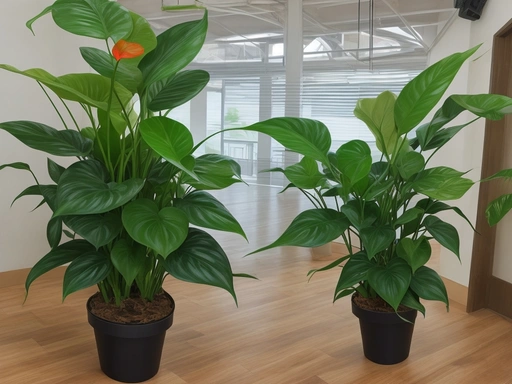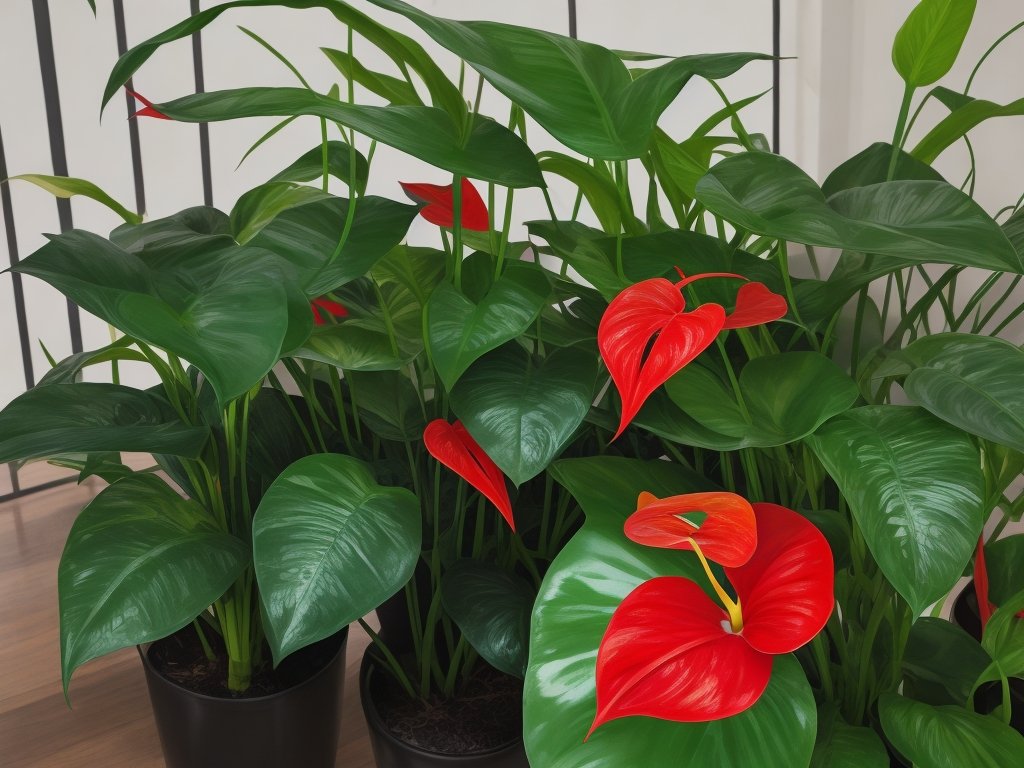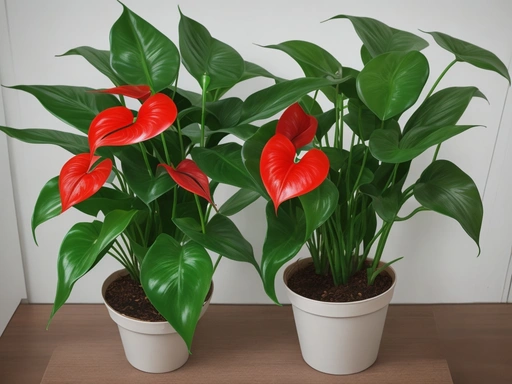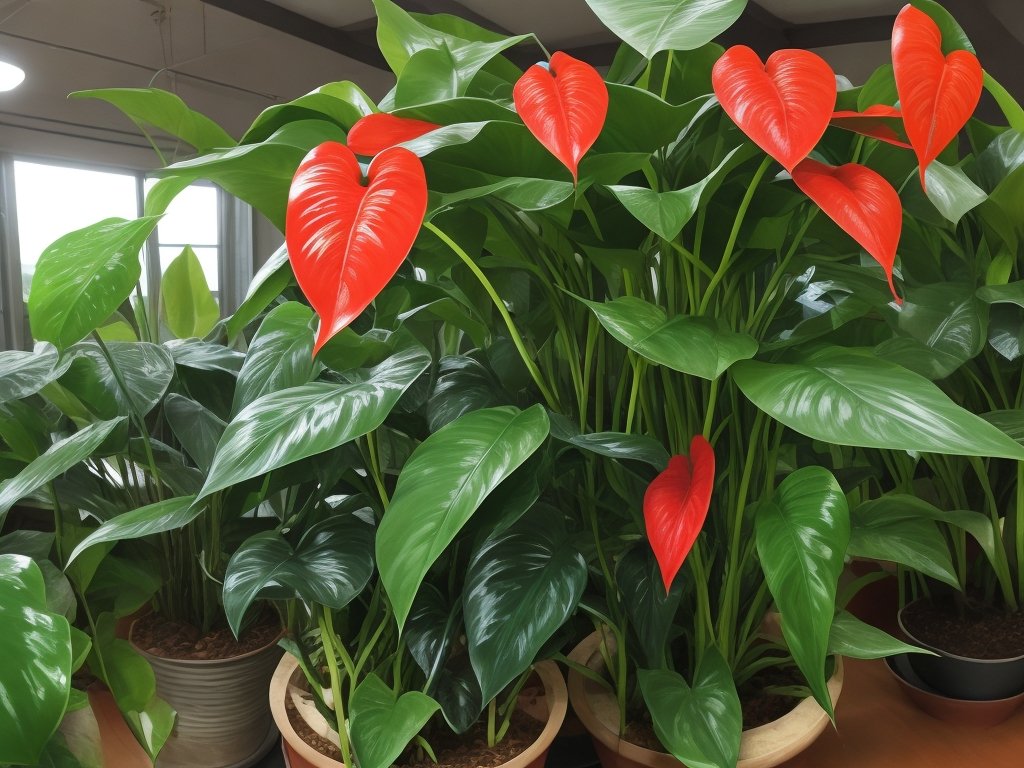Anthurium Species Overview: Exploring Nature’s Exotic Beauties
Key Takeaways:
- Anthurium species have a wide range of unique and vibrant colors, making them popular choices for indoor and outdoor plant enthusiasts.
- These plants require high humidity and indirect sunlight to thrive, so proper care and environmental conditions are crucial for their health.
- Anthuriums are known for their beautiful, heart-shaped flowers that can last for several weeks, adding a touch of elegance to any space.
- With a little bit of attention and care, Anthurium species can be long-lasting and rewarding plants to grow and enjoy.
Are you ready to dive into the enchanting world of Anthurium plants? These captivating beauties are sure to steal your heart with their vibrant colors and unique leaf shapes.
In this article, we’ll take a closer look at Anthurium species, from their fascinating history and origins to the popular varieties that every plant lover should know about.
We’ll also explore the care and maintenance tips to ensure your Anthurium plants thrive, as well as how to propagate them for more green goodness. Don’t worry, we’ll also tackle common problems and pests, and answer some of the most frequently asked questions about these stunning plants.
So, let’s get started on this Anthurium adventure!
| Species | Common Name | Origin | Flower Color | Leaf Color |
| Anthurium andraeanum | Flamingo Lily | Tropical America | Red, Pink, White | Green |
| Anthurium crystallinum | Crystal Anthurium | Colombia | Purple | Green, Silver |
| Anthurium scherzerianum | Red Anthurium | Costa Rica, Panama | Red | Green |
What is Anthurium?
Anthurium is a type of flowering plant known for its vibrant, heart-shaped blooms and glossy, green leaves.
History and origins of Anthurium
Anthurium is native to the tropical regions of Central and South America. It was first discovered by European explorers in the late 17th century and was brought back to Europe.
Since then, Anthurium has gained popularity worldwide for its unique and vibrant flowers.
Today, it is cultivated in various parts of the world for its ornamental value.
Popular Anthurium species
Let’s dive into some popular Anthurium species you’ll love!
Anthurium andraeanum
Anthurium andraeanum is a popular species of Anthurium known for its vibrant, heart-shaped flowers.
It originates from Colombia and Ecuador, and it’s commonly grown as a houseplant.
It requires bright indirect light, moderate watering, and well-draining soil.
With proper care, it can bloom for several months.

Anthurium scherzerianum
Anthurium scherzerianum, also known as the flamingo flower, is a popular species of Anthurium. It is native to Central and South America, and is valued for its vibrant red flowers and glossy dark green leaves.
This species prefers bright, indirect light and warm temperatures.
It requires regular watering to keep the soil moist, but not soggy. Well-draining soil and occasional fertilization are important for its healthy growth.
Regular pruning can help maintain its compact shape.
Overall, Anthurium scherzerianum is a beautiful and rewarding plant to have indoors.
Anthurium clarinervium
Anthurium clarinervium is a unique and beautiful plant known for its large, heart-shaped leaves with prominent white veins. It is native to Mexico and requires bright, indirect light, well-draining soil, and high humidity to thrive.
Regular watering and occasional fertilization will help it grow and flourish.
Pruning is also important to maintain its shape and remove any damaged or dead leaves. With proper care, Anthurium clarinervium can be a stunning addition to any indoor plant collection.
Anthurium veitchii
Anthurium veitchii is a popular species known for its large, heart-shaped leaves adorned with intricate white veins. It thrives in bright, indirect light and prefers moderate temperatures.
Water it when the top inch of soil is dry, and provide high humidity.
Use a well-draining soil mix and fertilize during the growing season. Pruning can help maintain its shape.
Propagate through division or stem cuttings.
Watch out for pests like aphids and mealybugs.
Care and maintenance of Anthurium species
Taking care of Anthurium species involves providing the right light and temperature, watering and humidity, soil and fertilizer, as well as regular pruning and grooming.
Light and temperature requirements
Anthurium plants thrive in bright, indirect light.
They should be placed near a window with filtered light or in a well-lit room.
Avoid direct sunlight as it can scorch the leaves.
Temperature-wise, Anthuriums prefer a warm environment with temperatures between 60-85°F (16-29°C).
Avoid extreme temperature fluctuations and cold drafts.

Watering and humidity needs
Anthurium plants have specific watering and humidity needs. It’s important to keep the soil consistently moist but not soggy.
Allow the top inch of soil to dry out between waterings to prevent overwatering.
Anthuriums thrive in humid environments, so it’s a good idea to increase humidity by misting the leaves or placing the plant on a tray with water and pebbles. Avoid placing the plant near drafts or heaters, as they can dry out the leaves.
Soil and fertilizer recommendations
Anthurium plants thrive in well-draining soil that allows the roots to breathe.
A good soil mix can include peat moss, perlite, and orchid bark.
Fertilize your Anthurium plants regularly with a balanced, water-soluble fertilizer, diluted to half the recommended strength.
Apply the fertilizer every two to four weeks during the growing season.
Avoid over-fertilization, as it can damage the roots.

Pruning and grooming tips
Pruning and grooming are important for maintaining the health and appearance of Anthurium plants. Here are a few tips:
- Remove dead or yellowing leaves: Regularly inspect your plant and trim off any dead or yellowing leaves. This not only improves the overall aesthetics but also prevents the spread of diseases.
- Trim leggy stems: If your Anthurium is becoming leggy and losing its compact shape, you can trim back the stems to promote bushier growth. Cut just above a leaf node to encourage new growth.
- Remove spent flowers: Once the flowers have faded, you can snip off the spent blooms. This helps redirect the plant’s energy towards producing new flowers.
- Clean the leaves: Dust can accumulate on the glossy leaves of Anthurium plants, affecting their ability to photosynthesize. Gently wipe the leaves with a damp cloth or use a soft brush to keep them clean and shiny.
Remember, always use clean and sharp pruning tools to avoid causing damage to the plants. And don’t forget to sterilize the tools between cuts if you’re working with multiple plants to prevent the spread of diseases.

Propagating Anthurium plants
Propagating Anthurium plants can be done through division, growing from seeds, or rooting cuttings.
Division of Anthurium plants
To divide an Anthurium plant, start by removing it from its pot and gently teasing apart the root ball into smaller sections with your hands or a clean knife.
Each division should have a healthy portion of roots and at least one leaf.
Plant the divisions in separate pots with well-draining soil, and water thoroughly.
Keep them in a warm and humid environment until they establish roots.
Growing Anthurium from seeds
Growing Anthurium from seeds is a reliable method but requires patience.
Start by collecting ripe berries and extracting the seeds.
Soak the seeds in water for a day, then remove the pulp.
Plant the seeds in a well-draining mixture of peat moss and perlite, keeping them moist and warm.
Germination can take several weeks to a few months.
Be patient and provide consistent care to help the seeds successfully grow into Anthurium plants.
Rooting Anthurium cuttings
To root Anthurium cuttings, follow these simple steps:
- Select a healthy stem with at least two nodes and a few leaves. Cut the stem just below a node.
- Dip the cut end into a rooting hormone powder, which can help stimulate root growth.
- Prepare a well-draining potting mix and moisten it slightly.
- Plant the cutting in the potting mix, making sure the node is buried and the leaves are above the surface.
- Place the pot in a warm and bright location with indirect sunlight.
- Keep the soil consistently moist, but not waterlogged.
- After a few weeks, roots should start to develop. You can gently tug on the cutting to check for resistance, indicating root growth.
- Once the roots are established, you can transplant the rooted cutting into a larger pot with a suitable soil mix for Anthurium plants.
Common problems and pests with Anthurium plants
Anthurium plants can experience leaf yellowing and browning, root rot, and pests such as aphids, thrips, and mealybugs.
Anthurium leaf yellowing and browning
Anthurium leaf yellowing and browning can be caused by overwatering, underwatering, excessive sunlight, or nutrient deficiencies.
water your Anthurium plantre to water your Anthurium plant properly, provide adequate sunlight without direct exposure, and fertilize regularly.
Avoid using tap water and ensure good drainage in the soil.
Pruning affected leaves can also help promote new growth.
Anthurium root rot
Anthurium root rot is a common problem where the roots of the plant become damaged and decayed. This is usually caused by overwatering or poor drainage, which leads to excessive moisture in the soil.
To prevent root rot, make sure to water your Anthurium plants only when the top inch of soil feels dry, and ensure that the container has drainage holes.
Using a well-draining potting mix and avoiding standing water can also help keep your Anthurium roots healthy.
Anthurium pests (such as aphids, thrips, and mealybugs)
Anthurium plants can be susceptible to pests like aphids, thrips, and mealybugs.
These pests can cause damage to the leaves, flowers, and overall health of the plant.
To deal with these pests, you can try a few methods such as regularly inspecting your plants, manually removing the pests, using organic insecticidal soaps or oils, and ensuring proper ventilation and hygiene.
Preventive measures like maintaining a clean environment and avoiding overwatering can also help in keeping these pests at bay.
Frequently Asked Questions about Anthurium species
How often should I water my Anthurium?
Anthuriums should be watered when the top inch of the soil feels dry.
Stick your finger in the soil to check.
Water thoroughly but let excess water drain away.
Avoid overwatering, as it can cause root rot.
Always adjust watering based on the specific needs of your plant and the environmental conditions.
Can Anthurium plants tolerate direct sunlight?
No, Anthurium plants cannot tolerate direct sunlight.
They prefer bright, indirect light, as direct sunlight can lead to sunburn on their delicate leaves.
Place them in a well-lit area away from direct sunlight to keep them healthy and thriving.
What is the best soil mix for Anthurium?
The best soil mix for Anthurium plants should be well-draining and rich in organic matter.
A good mix consists of equal parts peat moss or coco coir, perlite or pumice, and orchid bark or charcoal.
This combination provides proper aeration and moisture retention for healthy root growth.
How long does it take for Anthurium plants to flower?
Anthurium plants typically take about one to two years to start flowering after they have been established. The exact time can vary depending on factors such as the species, growing conditions, and care provided.
Providing the right amount of light, water, and nutrients can help encourage blooming and shorten the time it takes for Anthurium plants to produce flowers.
Final Verdict
Anthurium plants are a stunning addition to any indoor or outdoor space, with their vibrant colors and unique shapes.
With a rich history and origins in South America, these plants have become popular worldwide.
The Anthurium andraeanum, Anthurium scherzerianum, Anthurium clarinervium, and Anthurium veitchii are some of the most sought-after species.
To care for these plants, it’s important to provide the right light and temperature conditions, water and humidity requirements, as well as the proper soil and fertilizer.
Regular pruning and grooming will help maintain their appearance.
Propagating Anthurium plants can be done through division, growing from seeds, or rooting cuttings.
It’s important to watch out for common problems such as leaf yellowing and browning, root rot, and pests like aphids, thrips, and mealybugs.
Finally, frequently asked questions about watering, sunlight, soil, and flowering time have been addressed.
enjoy the beauty of Anthurium plantsutions for common issues, you can enjoy the beauty of Anthurium plants for years to come.
So go ahead and bring nature’s artistry into your home with Anthuriums!







